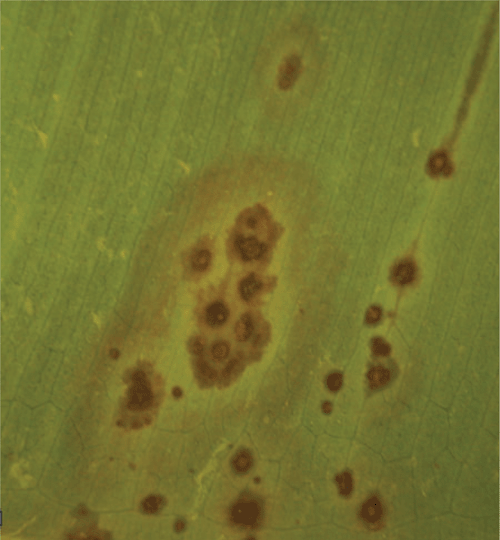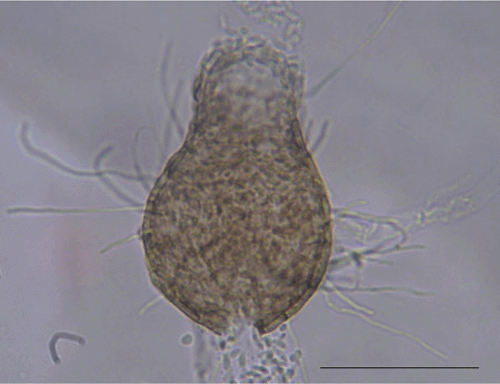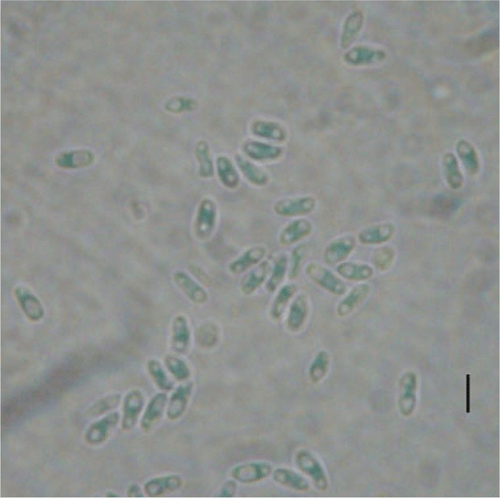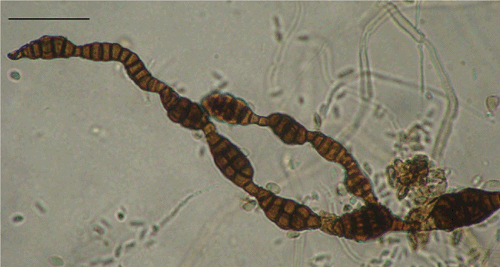First report of leaf spot disease on Ficus elastica caused by Phoma glomerata in Iran
B. Aghapour A B , K. B. Fotouhifar A , A. Ahmadpour A and K. Ghazanfari AA Department of Plant Protection, University College of Agriculture and Natural Resources, University of Tehran, Karaj, Iran.
B Corresponding author. Email: bijan.aghapour@gmail.com
Australasian Plant Disease Notes 4(1) 82-83 https://doi.org/10.1071/DN09035
Submitted: 22 July 2009 Accepted: 30 July 2009 Published: 24 August 2009
Abstract
During autumn of 2007, some leaves of Ficus elastica with leaf spot symptoms were collected from greenhouses in Karaj, Iran where the host is grown as an ornamental. Based on morphological characteristics, the causal agent of disease was determined as Phoma glomerata. Occurrence of leaf spot disease on F. elastica leaves caused by P. glomerata is reported for the first time in Iran.
Ficus elastica Roxb., also known as rubber fig, rubber bush or rubber plant, is an evergreen plant which is native to tropical areas of Asia, especially in India and in Iran often in greenhouses (Mozaffarian 2004). Phoma glomerata (Corda) Wollenw. & Hochapfel is a worldwide distributed soil fungus, which has been isolated from various kinds of plants (belonging to approximately 100 different host genera) as well as from animal (human) and inorganic materials (Boerema et al. 2004). It frequently occurs on dead seed coats. Most records are from temperate regions, but the fungus appears to be particularly common in the subtropics (Sutton 1980). It is frequently found in association with symptoms of blight, leaf spots and fruit rot (e.g. blight of vine flowers and grapes, Vitis vinifera, Vitaceae) throughout the world (Boerema et al. 2004). Generally, it is considered to be a secondary invader or opportunistic pathogen; this holds also for the various records of this fungus in association with mycotic diseases of humans (Punithalingam 1979). Also, this fungus was reported by Mathur (1979) on F. elastica from India. Phoma glomerata was reported from wheat (Triticum aestivum L.) and cucumber (Cucumis sativus L.) (Safaee et al. 2000; Hatami et al. 2008), but, so far, this species has not been observed on F. elastica from Iran.
During autumn of 2007, some leaves of F. elastica with leaf spot symptoms were collected from greenhouses of the University College of Agriculture, University of Tehran, in Karaj, Iran. The host is commonly used as an ornamental in Iran. Leaf spots were circular or irregular in shape (Fig. 1), separated or aggregated and often located at the margins of leaves. Leaf spots were brown at the margins and pale brown at the centers. A Phoma species was isolated from the regular or irregular lesions. The fungus was grown on malt extract agar (MEA) at 21°C for 7 days under continuously dark conditions. Growth rates of colonies were measured at 5–7 cm in diameter after 7 days. For stimulation of pycnidial formation, the fungus cultures were maintained in alternate light/dark conditions (13 h under near ultraviolet [near-UV] and 11 h under dark conditions) on MEA. Pycnidia were subglobose, 70–225 (117) µm in diameter (Fig. 2) and conidia were variable in shape and dimensions, mostly ovoid-ellipsoidal, sometimes curved, 4–8.5 (6.1) × 1.5–3.5 (2.9) µm in diameter and hyaline (Fig. 3). Chlamydospores were highly variable and irregular in shape and size, unicellular or multicellular, mostly intercalary, occasionally terminal-lateral, solitary or in chains, when septate usually dictyosporous, smooth subsequently verrucose or rarely tuberculate, brown and 21–45 (30.5) × 10–17 (13.1) µm in size (Fig. 4). Based on characteristics of the fungus colony, fruiting bodies and the conidia and chlamydospores produced in the culture medium, the fungus was determined as Phoma glomerata (Corda) Wollenw. & Hochapfel (Sutton 1980; Boerema et al. 2004).

|

|

|

|
Some healthy rubber fig plants (F. elastica) were used for pathogenicity tests under greenhouse conditions. Leaves were inoculated by spraying a conidial suspension (105 conidia/mL) of the fungus and were kept at 23 ± 2°C, at >75% RH. At the same time, some leaves were scratched with a sterile needle and the conidial suspension sprayed onto these wounded parts. Control plants were sprayed only with distilled water. After 4–5 days from inoculation, the results showed that the symptoms produced on the scratch-inoculated leaves were similar to those already observed in the greenhouse. In contrast, on healthy inoculated leaves with conidial suspension no symptoms developed after the same period of time. This is thought to be due to the thick waxy cuticle on Ficus. Occurrence of leaf spot disease caused by P. glomerata on F. elastica leaves is reported for the first time in Iran.
Acknowledgements
The authors would like to thank Dr. M. Javan-Nikkhah and Prof. S. M. Okhovvat for their excellent assistances.
Punithalingam E
(1979) Sphaeropsidales in culture from humans. Nova Hedwigia 31, 119–158.



